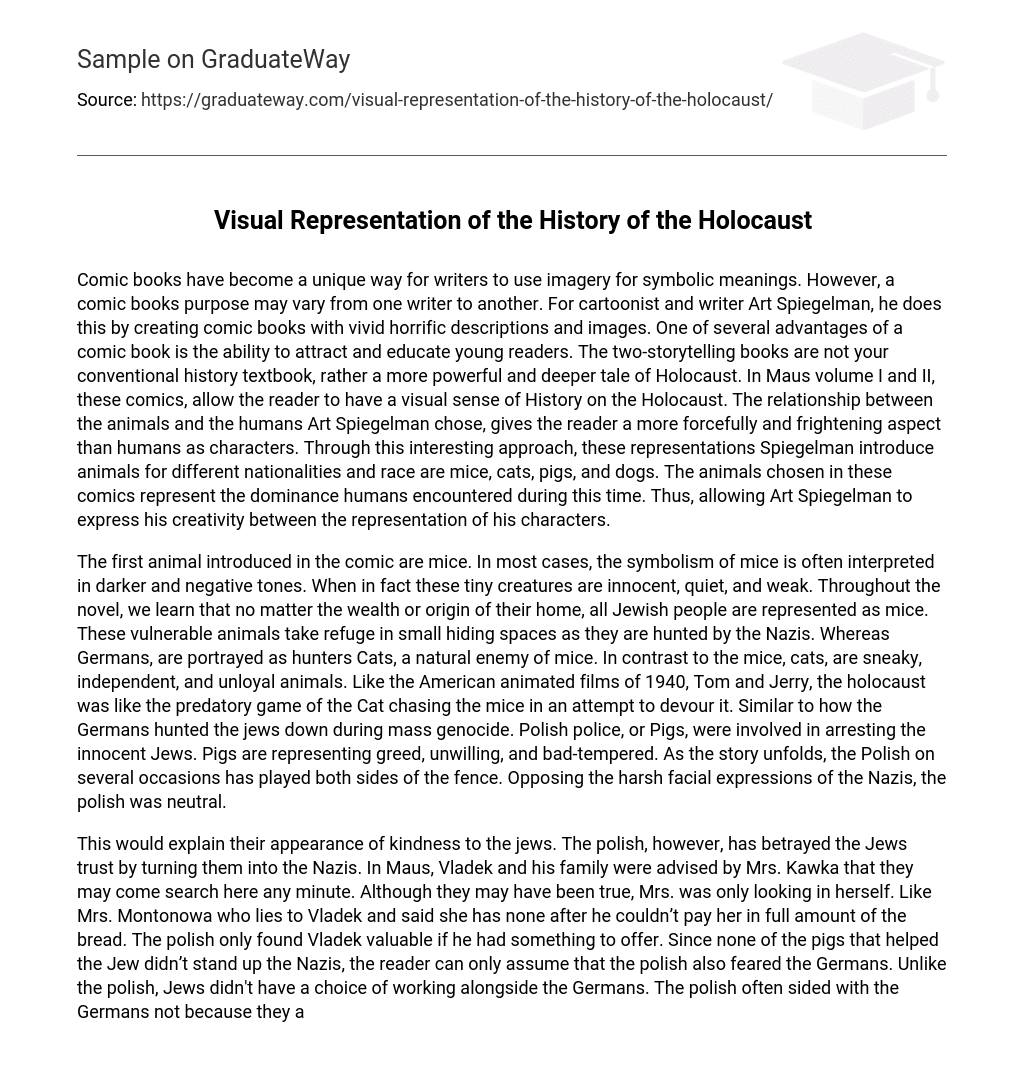Comic books have become a unique way for writers to use imagery for symbolic meanings. However, a comic books purpose may vary from one writer to another. For cartoonist and writer Art Spiegelman, he does this by creating comic books with vivid horrific descriptions and images. One of several advantages of a comic book is the ability to attract and educate young readers. The two-storytelling books are not your conventional history textbook, rather a more powerful and deeper tale of Holocaust. In Maus volume I and II, these comics, allow the reader to have a visual sense of History on the Holocaust. The relationship between the animals and the humans Art Spiegelman chose, gives the reader a more forcefully and frightening aspect than humans as characters. Through this interesting approach, these representations Spiegelman introduce animals for different nationalities and race are mice, cats, pigs, and dogs. The animals chosen in these comics represent the dominance humans encountered during this time. Thus, allowing Art Spiegelman to express his creativity between the representation of his characters.
The first animal introduced in the comic are mice. In most cases, the symbolism of mice is often interpreted in darker and negative tones. When in fact these tiny creatures are innocent, quiet, and weak. Throughout the novel, we learn that no matter the wealth or origin of their home, all Jewish people are represented as mice. These vulnerable animals take refuge in small hiding spaces as they are hunted by the Nazis. Whereas Germans, are portrayed as hunters Cats, a natural enemy of mice. In contrast to the mice, cats, are sneaky, independent, and unloyal animals. Like the American animated films of 1940, Tom and Jerry, the holocaust was like the predatory game of the Cat chasing the mice in an attempt to devour it. Similar to how the Germans hunted the jews down during mass genocide. Polish police, or Pigs, were involved in arresting the innocent Jews. Pigs are representing greed, unwilling, and bad-tempered. As the story unfolds, the Polish on several occasions has played both sides of the fence. Opposing the harsh facial expressions of the Nazis, the polish was neutral.
This would explain their appearance of kindness to the jews. The polish, however, has betrayed the Jews trust by turning them into the Nazis. In Maus, Vladek and his family were advised by Mrs. Kawka that they may come search here any minute. Although they may have been true, Mrs. was only looking in herself. Like Mrs. Montonowa who lies to Vladek and said she has none after he couldn’t pay her in full amount of the bread. The polish only found Vladek valuable if he had something to offer. Since none of the pigs that helped the Jew didn’t stand up the Nazis, the reader can only assume that the polish also feared the Germans. Unlike the polish, Jews didn’t have a choice of working alongside the Germans. The polish often sided with the Germans not because they agreed with their savagery but rather to have their lives and the lives of their families spared. As for the Americans, because they sympathized with the Jewish people are represented as dogs. Dogs are helpful, protective, compassionate, rescuers, and friendly. Though these are general symbolizations of these animals Spiegelman uses, they serve a great purpose for his novels.
By creating comic books, this helps the readers engage throughout the story of the Holocaust. The easily readable format Art Spiegelman uses his creativity in the structure in which the animals are portrayed. In doing this, Spiegelman gives the reader a glimpse of what it was like for Jews during this period. The Nazis haunt, torture and killed the weak Jews. In this era, Jews by far had the worst of these inhumane experiences. Authors often include symbolism or images that help the reader understand the effectiveness of a specific tale or event. Sometimes the symbols or metaphors used may seem offensive but are unintentional. For each reader, symbols may be analyzed in several different aspects. Most may disagree or viewed Spiegelman’s representations as offensive but without this images and symbolic animals, Spiegelman wouldn’t have able to create the elaborate and visual metaphor that adds an impression to his story.
Along with the animals, another example of symbolism in Maus. In most cases, authors do not include any unnecessary detail to their work. In volume II, Flies shown buzzing around Artie. The flies surrounding Artie are a present an image of death. Like the ‘Prisoner on the Hell Planet: A Case History.’ the reader learns another symbolization of death that haunts him.





